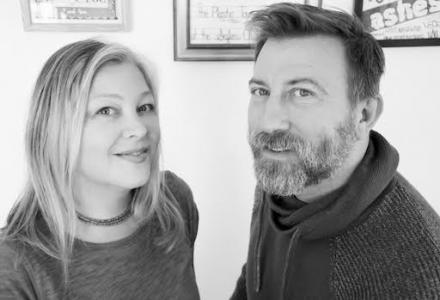
Shawna Kenney and Rich Dollinger of D.C.'s Safari Club

Interview by James Damion
From 1988-1998, Washington D.C.'s Safari Club played host
to countless touring and local acts. The impact of the club
would often be reflected in the stories bands shared about
their tours, giving color to the highlights of their stops
along the way. As a less traveled teen, hearing that my
friends had taken their van to Washington D.C. or California
was like a trip to the moon.
Seeing that most of the bars and venues that hosted bands
during our halcyon days are long gone, it's essential to
give attention and credit to the structures and people who
helped provide a space and environment to express the vision
of the punk rock movement of the Eighties and Nineties.
While I often regret not reviewing or interviewing them
at the time of the 2017 release of their book "Live
at the Safari Club:'A History of harDCore Punk in the Nation’s
Capital, 1988-1998," I felt it essential to track down
Rich Dollinger and Shawna Kenney to answer some questions
and share their Washington DC's legendary Safari Club memories.
Here’s what they had to say...
Q: I understand you’re originally from Alexandria,
Virginia. Was there anything going on there musically? Or
did you have to travel to nearby DC to get a taste?
Rich: Northern Virginia had a lot of good local bands.
Scream, Askance, Ipecac, Device, Avail, Initial Reaction.
So my bands could play locally in churches and small restaurants
that booked bands. But DC was a short metro ride away, so
DC felt just as local as any other town in Northern Virginia.
Q: We always hear about the early D.C. scene and
Revolution Summer bands. Yet aside from Fugazi and a few
others, the years that followed have trickled in rather
slowly. Was there a particular need for a place to host
all ages shows?
Rich: There was never a problem finding a place for all
ages shows in the DMV (DC/Maryland/Virginia) area. The Wilson
Center, St. Stephens Church, Sanctuary Theatre and even
Ft. Reno Park had all ages shows for years. Safari Club
was a happy accident.
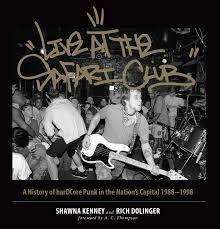
The Live At The Safari Club book by Shawna and Rich
Q: How did the opportunity to book shows there come
about?
Rich: I never booked shows. Shawna and Pam were the first
regular promoters at the Safari Club. Later, John Cornerstone
and Hard Karl took over. The club was shut down for a few
years before Martin Castro, Gabe Banner and Jon Hennessy
started booking there again under the name Chamber of Sound.
Shawna’s boyfriend’s band Indian Summer got
booked on a pay-to-play show at the Safari Club. Swiz was
also on that show but refused to play and took off. Indian
Summer decided to go along with it. Somehow when everyone
took off, Shawna got left at the club assuming her boyfriend
or someone from the band would come back for her. No one
ever came back. Shawna waited hours and befriended the owner.
He owned a cab company too and got her a ride home. In the
meantime she offered to book bands on the weekends during
the day. (The 9:30 Club didn’t have weekend matinees.)
He offered her two dates. The first show was all local bands.
The second show was Gorilla Biscuits, Swiz and Lucy Brown.
The owner was so impressed with the turnout, he wanted GB
every weekend!!
Q: Mentioning the Safari Club without bringing
up Shawna would be unfathomable. Had you known her prior
to the Safari Club and how did your relationship evolve?
Rich: I met Shawna years after she was booking shows. I
had met her partner Pam once, but never Shawna. We met in
1995 through Martin Castro (who was the current Safari Club
promoter). Shawna was hired to hang posters and hand out
promo CDs at a Slayer show in rural Maryland. Her car broke
down and she called Martin to see if he would drive her
to the show. He didn’t drive but asked if Shawna could
get a few more people into the show. He called me and asked
if I could drive them. I was available and the rest is history.
Shawna and I have been best friends since.
Q: Who were some of the other people who helped
shape and develop what made that block of cement so special?
Rich: I think it was the fact that the shows were during
the day and kids could spend the whole day there meeting
other kids from out of town and just really getting to know
each other. 9:30 shows were like “wham, bam, thank
you ma’am.” You were in and out and it was late
and you never really got to hang out. The bands were “pro”.
The Safari Club was for bands who couldn’t get shows
at 9:30. No contracts, no managers. It really was kids booking
kids for kids.
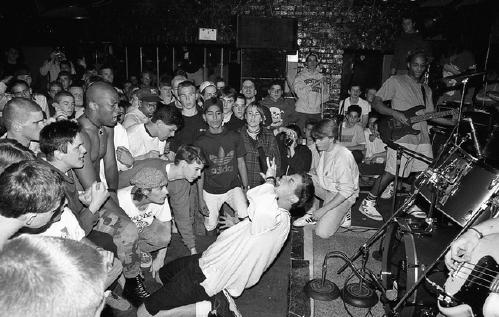 NYC's Underdog at the Safari Club. Photo by Joe Wongananda
NYC's Underdog at the Safari Club. Photo by Joe Wongananda
Q: One of the first things that come to mind when
thinking about the Safari Club is the diversity of the bills.
You booked bands that had a very broad sound and message.
For every hardcore band there was a Lucy Brown or Junk Yard
Band. How did that diversity foster itself and were there
times when you quickly realized you had chosen or booked the
wrong band for the kind of venue you were running? Meaning,
I love hardcore music and I love go-go music, but they don’t
necessarily go together.
Rich: Shawna and Pam booked crazy line ups. But I don’t
think go go bands played any of the hardcore shows. Sammy
had a cool story. He remembered packing up his drums while
the go go bands were loading in. He stuck around to see
what they were all about. But those shows were completely
different.
Shawna: Pam and I had eclectic punk taste. She was from
the Midwest, I was from the DC area. So we liked everything
from the Chicago Wax Tracks bands to Dischord groups to
New York hardcore and local little bands that no one had
ever heard of. We liked to mix it up. Metal, punk, ska,
it was all the same to us. Once we booked Murphy’s
Law with Crucial Youth opening and we thought that was hilarious
but I don’t think the crowd appreciated it the same
way we did. Some people were confused but we saw the humor
and I guess we were just entertaining ourselves. We weren’t
professional promoters.
Q: What were some of the issues you faced?
Shawna: The club owner was constantly pushing us to make
more money and thought he could push us around because we
were 18 year old girls. Sometimes certain bands had a bad
attitude, specifically The Dwarves. Eventually some bands
wanted us to sign contracts. We weren’t comfortable
with that. We were very lo-fi.
Q: Looking back, it seems as if every great music
venue was located within somewhat of a warzone. Can you
describe the Safari Clubs surroundings?
Rich: Safari was pretty close to the old 9:30 and DC Space.
So not too out of the way for 80's punks. There was a liquor
store across the street who would sell beer to 14 year old
kids. There was a trans hooker bar down the street. The
one time Dr. Know from the Bad Brains came out, his car
got broken into. Ken Olden had a story about a homeless
guy hitting him up for cash. Ken only had enough for the
show and maybe a record or shirt. The homeless guy told
him that if it was night time, he’d just rob him.
So people were calmer during the day, I guess.
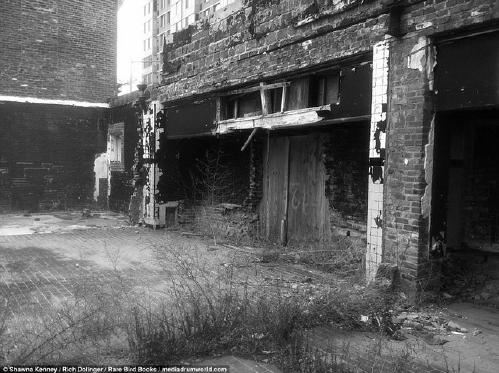 What's
left of The Safari Club today What's
left of The Safari Club today
Q: Most of the independent venues that book shows
inspired a sense of community that fostered a socio-political
idealism that spread throughout and often beyond their community.
“Food, not Bombs” immediately comes to mind. I
could only imagine what that could entail in a political hotbed
such as Washington DC. What, if anything was happening in
and around the club during the decade or so of the Safari
Club?
Rich: There were other outlets that got involved in that.
St. Stephens Church was where Mark Anderson and Positive
Force booked a lot of benefit shows. Also Ian MacKaye’s
dad had a office there. I think he had something to do with
the Washington Free Clinic, which was run out of there for
a while. There was also the Beehive Collective that was
more Riot Grrrl and political than Moshington DC’s
Safari Club. LOL The Safari Club promoters weren’t
particularly political. But the scene was into vegetarianism,
feminism, anti-racism etc. Coincidentally, it was the location
of the first ever PETA protest in 1980. Eight-nine years
later it was a hub for vegetarian/straight edge kids. The
club used to be a chicken processing plant that Ingrid wanted
to expose.
Q: Many of the bands I was friends with or interviewed
spoke highly of their visits and shows at Safari Club, giving
it an almost legendary status. Was there anything special
you offered to local and touring acts?
Rich: I think it was all about the scene. Kids from NY,
NJ, Philly, Delaware, Richmond, VA Beach, etc would travel
to Safari Club shows. There was always a positive vibe there.
Shawna: Several bands stayed at our house. We gave some
of them tours of the city. We tried to pay everyone. And
we paid the band who traveled the farthest the most. We
tried to book local, unknown bands with bigger touring bands.
We stayed friends with a lot of the bands we booked too.
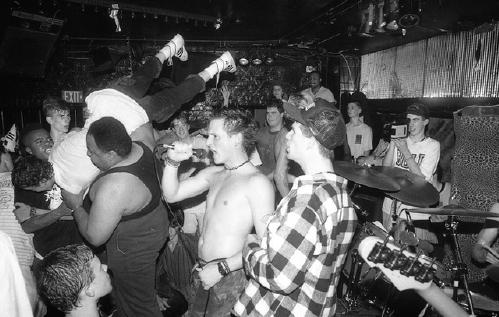 Token Entry and friends onstage with Big Chuck The Bouncer
at The Safari Club.
Token Entry and friends onstage with Big Chuck The Bouncer
at The Safari Club.
Photo by Joe Gongananda
Q: As someone who went to the majority of his hardcore
matinees at CGBG’s, I got to know some of the bouncers.
Can you tell us a little bit about “Big Chuck”
and his presence at shows?
Shawna: When we first started booking bands there, the
club had their own security team, which they wanted to pay
out of the money from the door. Pam and I were not happy
about that and did not think that we needed security and
felt we could police our own scene. But Big Chuck was cool.
He was a bouncer for many of the go go bands and he bounced
big hip-hop shows at the Capital Center. So we kept him
on board. After a while he started to understand hardcore
dancing better and we developed a very friendly relationship
with him.
Q: The club had a solid ten year run. I’m
sure you booked/experienced some pretty mind blowing shows.
What stands out for you all these years later?
Rich’s highlights:
1. First Shelter show ever. Ray came down with Judge and
wanted play a couple Shelter songs before Judge went on.
Most of us were too young to have ever seen YOT. So this
was our first time seeing Ray in action.
2. Taylor from 4 Walls singing for Sick Of It All because
Lou’s eye got cut up pretty bad.
3. Bad Trip’s trampoline.
4. Judge doing "NY Crew" impromptu and changing
it to "DC Crew."
5. Getting the Gorilla Biscuits' "Live At The Safari
Club 7-inch and hearing all of our friends singing along.
Shawna: It was exciting booking GB. Their first 7-inch had
just come out and we had listened to it at nauseam! I also
really loved Underdog and was excited seeing them in person.
And Token Entry! I had seen in Baltimore a year before booking
them. It was great seeing their energy at the Safari Club.
Q: It’s hard to think of anything worse than
a fire. Can you describe what happened? The immediate and
long term effects? Was there ever the thought or intention
of moving forward and finding a new venue to book shows?
Rich: The club burned down in 1997. Me and Shawna moved
to California a year earlier. So we’ve only heard
second-hand what happened. Kurt Powers from Time Flies was
so bummed because his band’s first show was the last
booked show at the Safari Club. When the bands got to the
club it was burned down and they had to move the show to
the trans bar down the street. After that, kids started
booking shows at the churches and VFW halls in the suburbs.
Q: How did the idea of the book “Live at the
Safari Club” come about? Can you share the process
with me and how you got everyone involved?
Rich: Shawna and Dave Brown were on the Dissonance
PodCast hosted by Mike Paarlberg in 2011. Dave brought
up making a documentary about the Safari Club but we knew
there wasn’t enough good video footage. Then we stumbled
onto Joe Wongananda's photos. We used his photos on friends’
7-inch record covers for Release, Four Walls Falling, etc.
We thought it be great to make a book. It took over six
years to gather everything. We had two computers stolen
at one point and had to start over. We pulled apart the
interviews to try to tell the story from many points of
views. It was great reconnecting with old friends and meeting
people who were around but we never new.
New and used copies of Live At The Safari Club
are available from online retailers.
|

